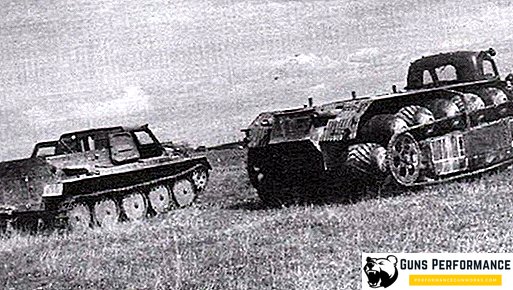The spear is known to man since ancient times - but much and little is written about this piercing weapon at the same time. It is difficult to say why this happened. Most of the authors who spoke about this weapon recall the stone edges of the Mesolithic times, Roman pilum, tournament spears and Russian spears.
The latter type of weapon, by the way, can be called Russian with a considerable stretch. But first things first.

A bit of history
Weapons are essentially the same age as humanity. The first spear in history was an ordinary pointed stick. It appeared, by the way, much earlier than the first stone tools. This is due to the ease of manufacture of such devices. The end of the wood was burned on the fire (and he became known a little before the way to trim the cobblestones, this will be confirmed by any knowledgeable archaeologist), and then the charred wood was simply scraped off the surface of the spear. Then the man discovered that the split bones of animals have sharp edges and planted such a fragment on the pole ... in a word, this is how the evolution of the weapon began, which later would rightfully be called "the machine gun of the Middle Ages."

Will return - will not return
Why is a stick with a tip called a gun? It's simple: a spear for a very long time remained the most long-range weapons available. Bow, sling, crossbow, catapult - all this was invented much later. And from ancient times the main weapon of a hunter and a warrior still remained a spear.
And here begins the full leapfrog. The man learned to process the stone, and the spears acquired the appropriate tips. With a razor sharpness, a shard of flint inserted into the split of the pole was leaf-shaped and used mainly in hunting. Why? The streamlined shape of the tip allowed, after the strike, to remove the weapon, without losing the stone edge, and to strike again.
By the way, it was quickly noticed that when striking a bone, particles are broken off from flint, leading to inflammation of the wound. Of course, the hunters as a result came up with the idea of the so-called "swept" tip. Now the striking element remained in the body of the victim, and it was impossible to remove it. Yes, and it was attached to the pole not tightly, so that the stick remained the hands of a hunter or a warrior - and the flint around was scattered a lot.
Metal age
Having skipped several epochs at once, we will find ourselves in the Roman Empire. This is where the spear was held in high esteem! Rome "pilum" - it is probably, and should be called an automaton of those times. The massive, but not very long shaft allowed you to throw this spear at the opponent's shield. It was in the shield, because the task of the Roman spearman was not to hit the enemy, but to deprive him of his ability to defend himself. Under the weight of the pilum, the enemy had to lower or throw the shield, and then the gladiuses of the warriors entered into the matter. It was impossible to chop off such an appendage stuck in the shield because of the tip length. The warrior simply did not reach the shaft with a sword or an ax.

Another use of the spear was found by Alexander the Great. His phalanxes, bristling with spears, were both an offensive force and a mobile fortification. The phalangites, armed with long spears, did not allow the enemy to approach the strike distance, and the light infantry with a shorter throwing weapon, deliberately knocked out enemy manpower. The effectiveness of such tactics and weapons is best indicated by the fact that Alexander conquered such a huge territory that he himself was upset: they said, there was nothing more to seize.
Fame record
It so happened that the most famous of all cold weapons have swords. Claymore, katana, kopes - these names are familiar to every lover of "slaughter" iron. But spears for some reason have gained much less popularity. The indisputable record holder can rightly be considered the "Longin's spear", it is also the "Spear of fate." According to legend, these weapons put an end to the suffering of Jesus Christ during his crucifixion on Bald Mountain. It is known that Hitler really wanted to take possession of him - but something didn’t grow together, and the fateful tip (the shaft was lost after years) still remains in one of the churches of Georgia or Armenia (according to various sources). By the way, the American director Francis Lawrence arbitrarily "moved" the tip to Mexico to make it easier for him to get to the main character of the film "Constantine" with Keanu Reeves.
Another famous spear was "noted" in history in the era of knightly tournaments, and long before that it was mentioned in the quatrain of Nostradaus. This is probably the only prediction that came true during the life of the author. He is known as “About the death of an old lion in a duel with a young one who“ pokes out his eyes. ”Indeed, the split spear of Count Montgomery entered the monarch's eye socket through the slit and caused his tragic death.
Continuation, as they say, follows.












